The Application of 2,6-Bis(4-Methoxybenzoyl)-Diaminopyridine in Solvent Extraction and Polymer Membrane Separation for the Recovery of Au(III), Ag(I), Pd(II) and Pt(II) Ions from Aqueous Solutions
Abstract
:1. Introduction
2. Results and Discussion
2.1. The Stability Constants of Complexes Formed by Precious Metal Ions with 2,6-Bis(4-Methoxybenzoyl)-Diaminopyridine
2.2. Classic Solvent Extraction
2.3. Membrane Extraction and Back-Extraction Processes
3. Comparison of the Efficiency of Studied Processes
4. Materials and Methods
4.1. Materials
4.2. Determination of Stability Constants of Complexes of Au(III), Ag(I), Pd(II) or Pt(II) with 2,6-Bis(4-Methoxybenzoyl)-Diaminopyridine
4.3. Separation Processes
4.3.1. Classic Solvent Extraction
4.3.2. Membrane Extraction Processes
The Preparation of Polymer Membranes
Membrane Extraction and Back Extraction Experiments
5. Conclusions
Author Contributions
Funding
Institutional Review Board Statement
Informed Consent Statement
Data Availability Statement
Conflicts of Interest
References
- Nguyen, T.H.; Lee, M.S. A Review on Separation of Gallium and Indium from Leach Liquors by Solvent Extraction and Ion Exchange. Miner. Process. Extr. Metall. Rev. 2019, 40, 278–291. [Google Scholar] [CrossRef]
- Shen, L.T.; Tesfaye, F.; Li, X.B.; Lindberg, D.; Taskinen, P. Review of rhenium extraction and recycling technologies from primary and secondary resources. Miner. Eng. 2021, 161, 106719. [Google Scholar] [CrossRef]
- Liddell, K. Thermodynamic models for liquid-liquid extraction of electrolytes. Hydrometallurgy 2005, 76, 181–192. [Google Scholar] [CrossRef]
- Sarode, D.B.; Attarde, S.B.; Ingle, S.T.; Srivastava, V.; Sillanpaa, M.E.T. Separation and removal of Cu2+, Fe2+, and Fe3+ from environmental waste samples by N-benzoyl-n-phenylhydroxylamine. Environ. Technol. 2015, 36, 521–528. [Google Scholar] [CrossRef]
- Meshram, P.; Abhilash; Pandey, B.D. Advanced Review on Extraction of Nickel from Primary and Secondary Sources. Miner. Process. Extr. Metall. Rev. 2019, 40, 157–193. [Google Scholar] [CrossRef]
- Sethurajan, M.; van Hullebusch, E.D.; Fontana, D.; Akcil, A.; Deveci, H.; Batinic, B.; Leal, J.P.; Gasche, T.A.; Kucuker, M.A.; Kuchta, K.; et al. Recent advances on hydrometallurgical recovery of critical and precious elements from end of life electronic wastes-a review. Crit. Rev. Env. Sci. Tec. 2019, 49, 212–275. [Google Scholar] [CrossRef] [Green Version]
- Ineza, C.; Pearce, B.H.; Begum, N.M.; Luckay, R. The synthesis and use of new amic acid extractants for the selective extraction of Cu(II),Ni(II) and Co(II) from other base metal ions in acidic medium. Sep. Sci. Technol. 2021, 1–15. [Google Scholar] [CrossRef]
- Tomizaki, K.; Okamoto, T.; Tonoda, T.; Imai, T.; Asano, M. Selective Gold Recovery from Homogenous Aqueous Solutions Containing Gold and Platinum Ions by Aromatic Amino Acid-Containing Peptides. Int. J. Mol. Sci. 2020, 21, 5060. [Google Scholar] [CrossRef]
- Sathuluri, R.R.; Kurniawan, Y.S.; Kim, J.Y.; Maeki, M.; Iwasaki, W.; Morisada, S.; Kawakita, H.; Miyazakiv, M.; Ohto, K. Droplet-based microreactor system for stepwise recovery of precious metal ions from real waste with calix[4]arene derivatives. Sep. Sci. Technol. 2018, 53, 1261–1272. [Google Scholar] [CrossRef]
- Xue, D.; Li, T.; Liu, Y.; Yang, Y.; Zhang, Y.; Cui, J.; Guo, D. Selective adsorption and recovery of precious metal ions from water and metallurgical slag by polymer brush Graphene-polyurethane composite. React. Funct. Polym. 2019, 136, 138–152. [Google Scholar] [CrossRef]
- Bulgariu, L.; Bulgariu, D. Extraction of gold(III) from chloride media in aqueous polyethylene glycol-based two-phase system. Sep. Purif. Technol. 2011, 80, 620–625. [Google Scholar] [CrossRef]
- Zakhodyaeva, Y.A.; Zinov’eva, I.V. Extraction of Pt(IV) and Pd(II) from Hydrochloric Acid Solutions Using Polypropylene Glycol 425. Theor. Found. Chem. Eng. 2021, 55, 282–289. [Google Scholar] [CrossRef]
- Zakhodyaeva, Y.A.; Zinov’eva, I.V.; Tokar, E.S.; Voshkin, A.A. Complex Extraction of Metals in an Aqueous Two-Phase System Based on Poly(Ethylene Oxide) 1500 and Sodium Nitrate. Molecules 2019, 24, 4078. [Google Scholar] [CrossRef] [PubMed] [Green Version]
- Carner, C.A.; Croft, C.F.; Kolev, S.D.; Inês, M.G.S.; Almeida, G.S. Green solvents for the fabrication of polymer inclusion membranes (PIMs). Sep. Purif. Technol. 2020, 239, 116486. [Google Scholar] [CrossRef]
- Kolev, S.D.; Inês, M.; Almeida, G.S.; Cattrall, R.W. Polymer Inclusion Membranes. In Smart Materials for Sensing and Separation; de la Guardia, M., Esteve-Turrillas, F.A., Eds.; John Wiley & Sons Ltd.: Hoboken, NJ, USA, 2019. [Google Scholar] [CrossRef]
- Wilson, A.M.; Bailey, P.J.; Tasker, P.A.; Turkington, J.R.; Grant, R.A.; Love, J.B. Solvent extraction: The coordination chemistry behind extractive metallurgy. Chem. Soc. Rev. 2014, 43, 123–134. [Google Scholar] [CrossRef] [Green Version]
- Rao, M.D.; Singh, K.K.; Morrison, C.A.; Love, J.B. Challenges and opportunities in the recovery of gold from electronic waste. RSC Adv. 2020, 10, 4300–4309. [Google Scholar] [CrossRef] [Green Version]
- Wongsawa, T.; Traiwongsa, N.; Pancharoen, U.; Nootong, K. A review of the recovery of precious metals using ionic liquid extractants in hydrometallurgical processes. Hydrometallurgy 2020, 198, 105488. [Google Scholar] [CrossRef]
- Wang, Y.T.; Liu, M.; Tang, N.; Li, S.J.; Sun, Y.; Wang, S.X.; Yang, X.J. Equilibrium and mechanism studies of gold(I) extraction from alkaline aurocyanide solution by using fluorine-free ionic liquids. Rare Met. 2021, 40, 1987–1994. [Google Scholar] [CrossRef]
- Witt, K.; Urbaniak, W.; Kaczorowska, M.A.; Bożejewicz, D. Simultaneous Recovery of Precious and Heavy Metal Ions from Waste Electrical and Electronic Equipment (WEEE) Using Polymer Films Containing Cyphos IL 101. Polymers 2021, 13, 1454. [Google Scholar] [CrossRef]
- Nag, A.; Islam, M.R.; Pradeep, T. Selective Extraction of Gold by Niacin. ACS Sustain. Chem. Eng. 2021, 9, 2129–2135. [Google Scholar] [CrossRef]
- Bonggotgetsakul, Y.Y.N.; Cattrall, R.W.; Kolev, S.D. Recovery of gold from aqua regia digested electronic scrap using a poly(vinylidene fluoride-co-hexafluoropropene) (PVDF-HFP) based polimer inclusion membrane (PIM) containing Cyphos IL 104. J. Membr. Sci. 2016, 514, 274–281. [Google Scholar] [CrossRef]
- Nowik-Zając, A.; Zawierucha, I.; Kozłowski, C. Selective removal of silver(I) using polymer inclusion membranes containing calixpyrroles. RSC Adv. 2019, 9, 31122. [Google Scholar] [CrossRef] [Green Version]
- Fajar, A.T.N.; Kubota, F.; Firmansyah, M.L.; Goto, M. Separation of palladium(II) and rhodium(III) using a polymer inclusion membrane containing a phosphonium-based ionic liquid carrier. Ind. Eng. Chem. Res. 2019, 58, 22334–22342. [Google Scholar] [CrossRef]
- Kubota, F.; Kono, R.; Yoshida, W.; Sharaf, M.; Kolev, S.D.; Goto, M. Recovery of gold ions from discarded mobile phone leachate by solvent extraction and polymer inclusion membrane (PIM) based separation using an amic acid extractant. Sep. Sci. Technol. 2019, 214, 156–161. [Google Scholar] [CrossRef]
- Bożejewicz, D.; Witt, K.; Kaczorowska, M.A. The comparison of the removal of copper(II) and zinc(II) ions from aqueous solution using 2,6-diaminopyridine in a polymer inclusion membrane and in a classic solvent extraction. Desalin. Water Treat. 2021, 214, 194–202. [Google Scholar] [CrossRef]
- Bożejewicz, D.; Witt, K.; Kaczorowska, M.A.; Ośmiałowski, B. The Copper(II) Ions Solvent Extraction with a New Compound: 2,6-Bis(4-Methoxybenzoyl)-Diaminopyridine. Processes 2019, 7, 954. [Google Scholar] [CrossRef] [Green Version]
- Witt, K.; Bożejewicz, D.; Kaczorowska, M.A. N,N′-Bis(salicylidene)ethylenediamine (Salen) as an active compound for the recovery of Ni(II), Cu(II), and Zn(II) ions from aqueous solutions. Membranes 2020, 10, 60. [Google Scholar] [CrossRef] [PubMed] [Green Version]
- Yoshida, W.; Baba, Y.; Kubota, F.; Kamiya, N.; Goto, M. Extraction and stripping behavior of platinum group metals using an amic-acid-type extractant. J. Chem. Eng. Japan 2017, 50, 521–526. [Google Scholar] [CrossRef]
- Alam, M.S.; Inoue, K. Extraction of rhodium from other platinum group metals with Kelex 100 from chloride media containing tin. Hydrometallurgy 1997, 46, 373–382. [Google Scholar] [CrossRef]
- Al-Bazi, S.J.; Freiser, H. Phase-transfer catalysts in extraction kinetics: Palladium extraction by dioctyl sulfide and Kelex 100. Inorg. Chem. 1989, 28, 417–420. [Google Scholar] [CrossRef]
- De San Miguel, E.R.; Garduno-Garcia, A.V.; Aguilae, J.C.; de Gyves, J. Gold(III) transport polymer inclusion membranes: Efficiency factors and pertraction mechanism using Kelex 100 as carrier. Ind. Eng. Chem. Res. 2007, 46, 2861–2869. [Google Scholar] [CrossRef]
- Nowik-Zając, A.; Zawierucha, I.; Kozlowski, C. Selective transport of Ag(I) through a polymer inclusion membrane containing a calix[4]pyrrole derivatives from nitrate aqueous solution. Int. J. Mol. Sci. 2020, 21, 5348. [Google Scholar] [CrossRef]
- Akin, I.; Erdemir, S.; Yilmaz, M.; Ersoz, M. Calix[4]arene derivative bearing imidazole groups as carrier for the transport of palladium by using bulk liquid membrane. J. Hazadr. Mater. 2012, 223–224, 24–30. [Google Scholar] [CrossRef] [PubMed]
- Cieszynska, A.; Wisniewski, M. Extraction of palladium(II) from chloride solutions with Cyphos IL 101/toluene mixtures as novel extractant. Sep. Purif. Technol. 2010, 73, 202–207. [Google Scholar] [CrossRef]
- Mahandra, H.; Faraji, F.; Ghahreman, A. Novel extraction process for gold recovery from thiosulfate solution using phosphonium ionic liquids. ACS Sustain. Chem. Eng. 2021, 9, 8179–8185. [Google Scholar] [CrossRef]
- Regel-Rosocka, M.; Rzelewska, M.; Baczynska, M.; Janus, M.; Wisniewski, M. Removal of palladium(II) from aqueous chloride solution with cyphos phosphonium ionic liquids as metal ion carriers for liquid-liquid extraction and transport across polymer inclusion membrane. Physicochem. Probl. Miner. Process. 2015, 51, 621–631. [Google Scholar]
- Cieszynska, A.; Wiśniewski, M. Extractive recovery of palladium(II) from hydrochloric acid solutions with Cyphos IL 104. Hydrometallurgy 2012, 113–114, 79–85. [Google Scholar] [CrossRef]
- Sarkar, S.G.; Dhadke, P.M. Solvent extraction separation of gold with Cyanex 302 as extractant. J. Chin. Chem. Soc. 2000, 47, 869–973. [Google Scholar] [CrossRef]
- Laki, S.; Shamsabadi, A.A.; Kargari, A. Comparative solvent extraction study of silver(I) by MEHPA and Cyanex 302 as acidic extractants in a new industrial diluent (MIPS). Hydrometallurgy 2016, 160, 38–46. [Google Scholar] [CrossRef]
- Othman, N.; Noah, N.F.M.; Sulaiman, R.N.R.; Abdullah, N.A.; Bachok, S.K. Liquid-liquid extraction of palladium from simulated liquid waste using phosphinic acid as a carrier. J. Teknol. 2014, 68, 41–45. [Google Scholar] [CrossRef] [Green Version]
- Bonggotgetsakul, Y.Y.N.; Cattrall, R.W.; Kolev, S.D. Extraction of gold(III) from hydrochloric acid solutions with a PVC-based polymer inclusion membrane (PIM) containing Cyphos IL 104. Membranes 2015, 5, 903. [Google Scholar] [CrossRef] [PubMed] [Green Version]
- Li, X.; Wei, C.; Deng, Z.; Li, C.; Fan, G.; Rong, H.; Zhang, F. Extraction and separation of indium and copper from zinc residue leach liquor by solvent extraction. Sep. Purif. Technol. 2015, 156, 348–355. [Google Scholar] [CrossRef]
- Witt, K.; Radzyminska-Lenarcik, E.; Kosciuszko, A.; Gierszewska, M.; Ziuziakowski, K. The influence of the morphology an mechanical properties of polymer inclusion membanes (PIMs) on zinc ion separation from aqueous solutions. Membranes 2018, 10, 134. [Google Scholar] [CrossRef] [Green Version]
- Rostamian, R.M.; Heidarpour, S.F.; Mousavi, M. Afyuni, Characterization and sodium sorption capacity of biochar and activated carbon prepared from rice husk. J. Agric. Sci. Technol. 2015, 17, 1057–1069. [Google Scholar]
- Ipeaiyeda, A.R.; Tesi, G.O. Sorption and desorption studies on toxic metals from brewery effluent using eggshell as adsorbent. Adv. Nat. Sci. 2014, 7, 15–24. [Google Scholar] [CrossRef]

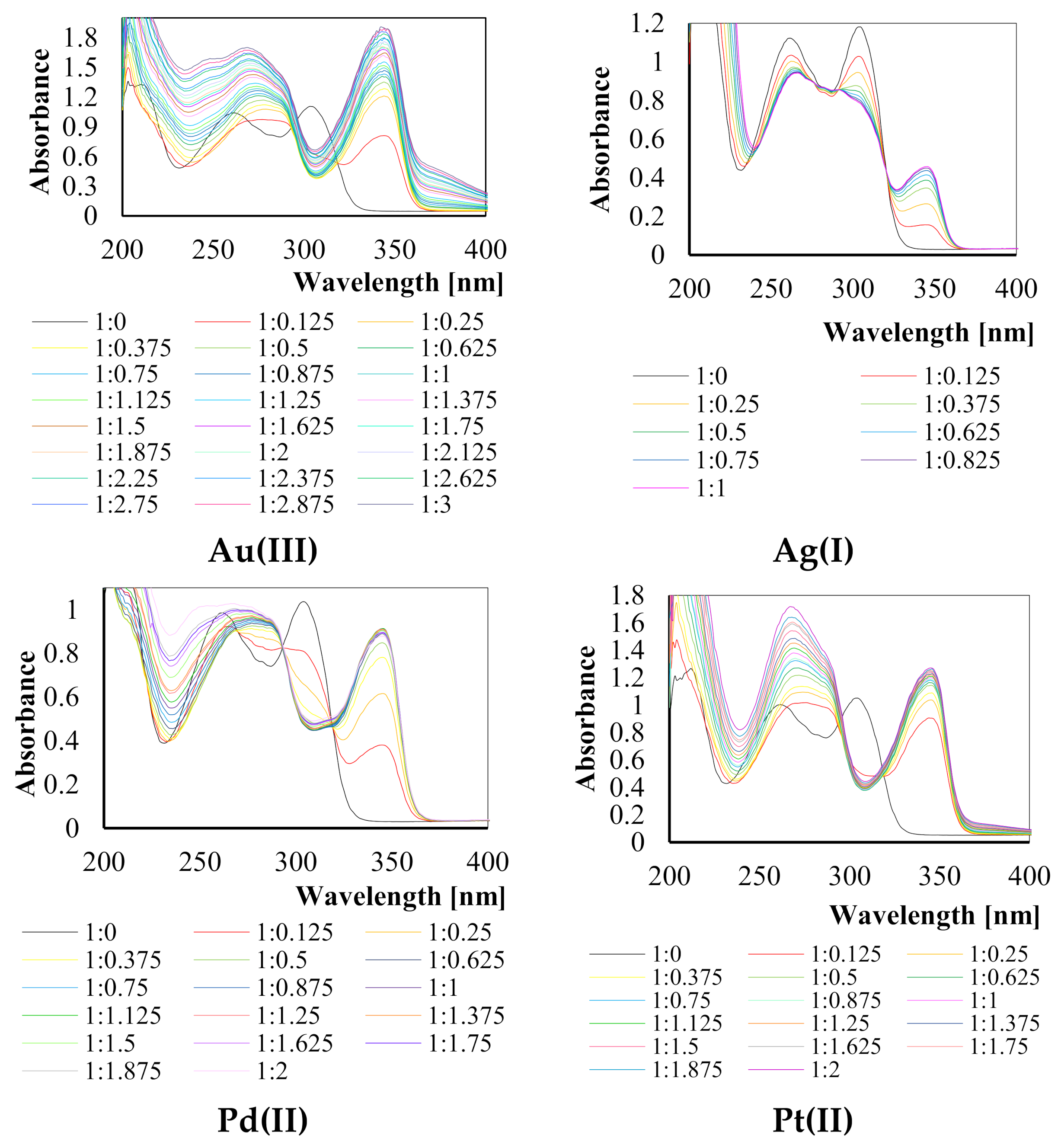
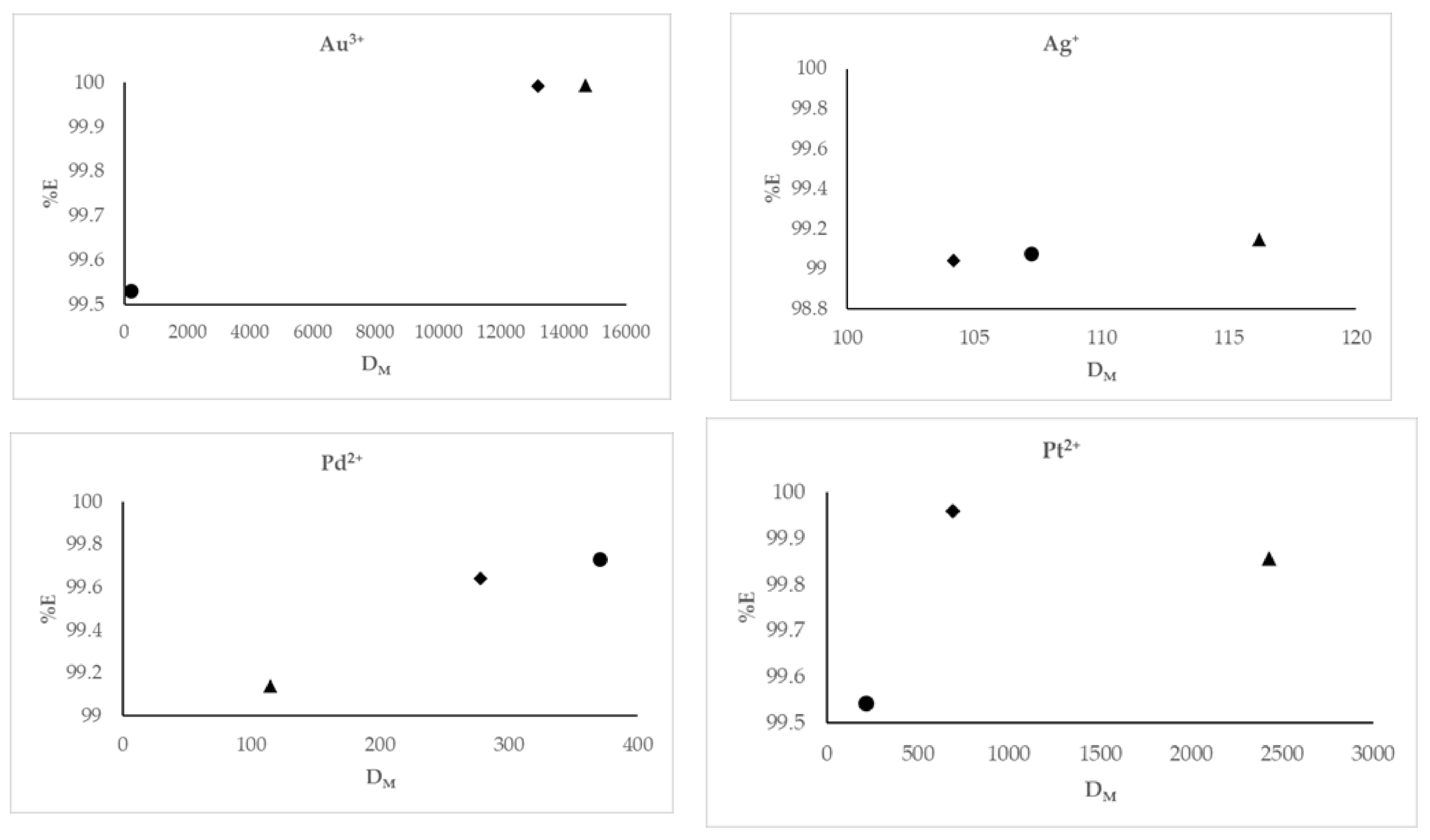
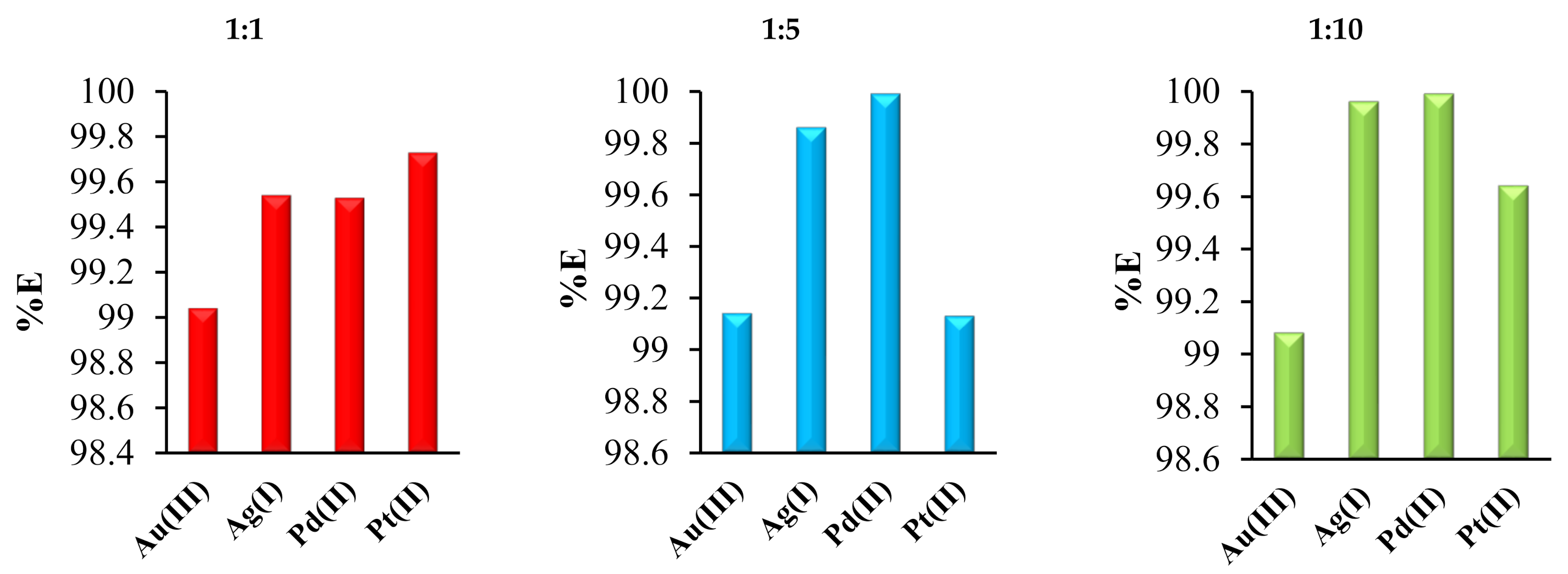
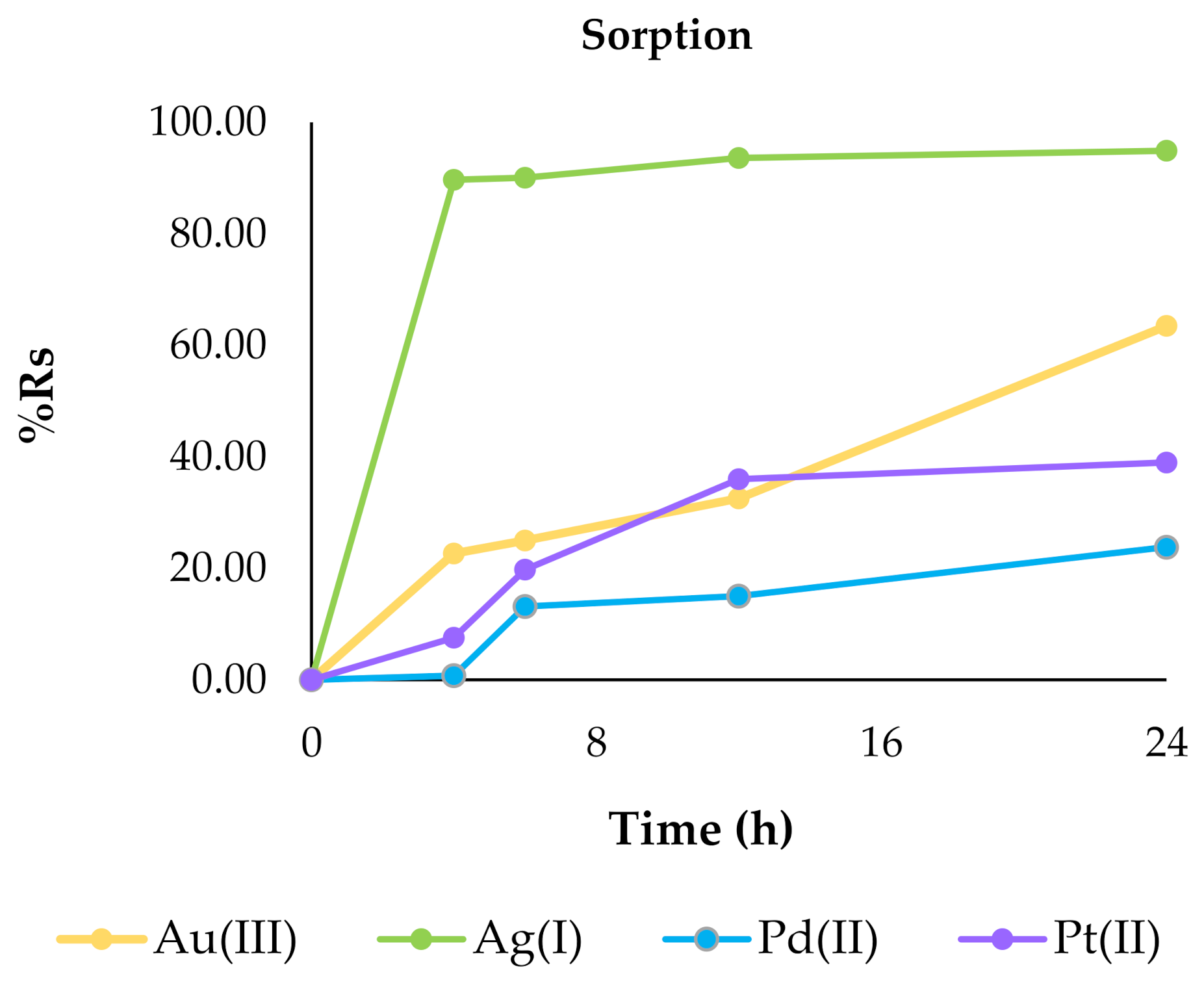
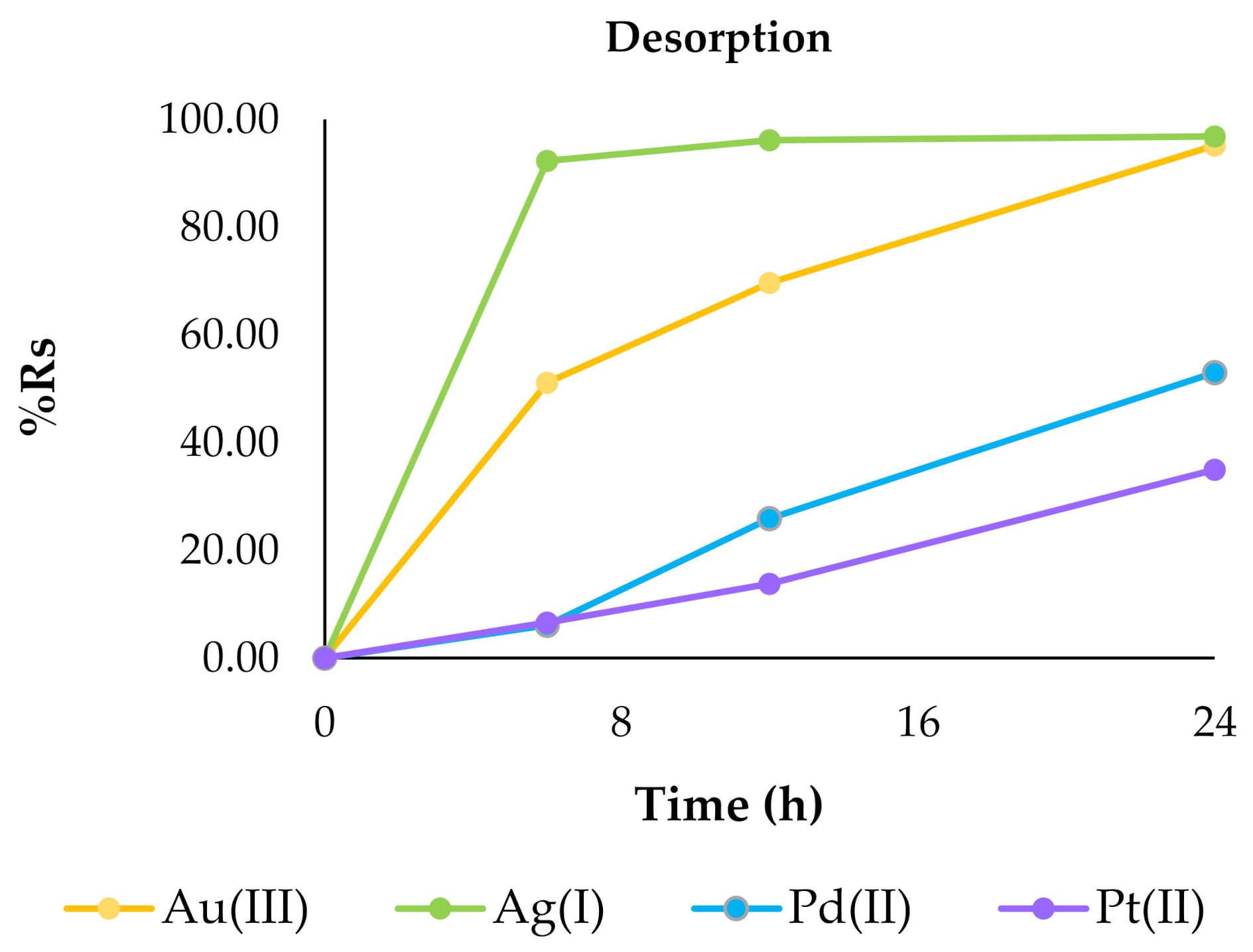
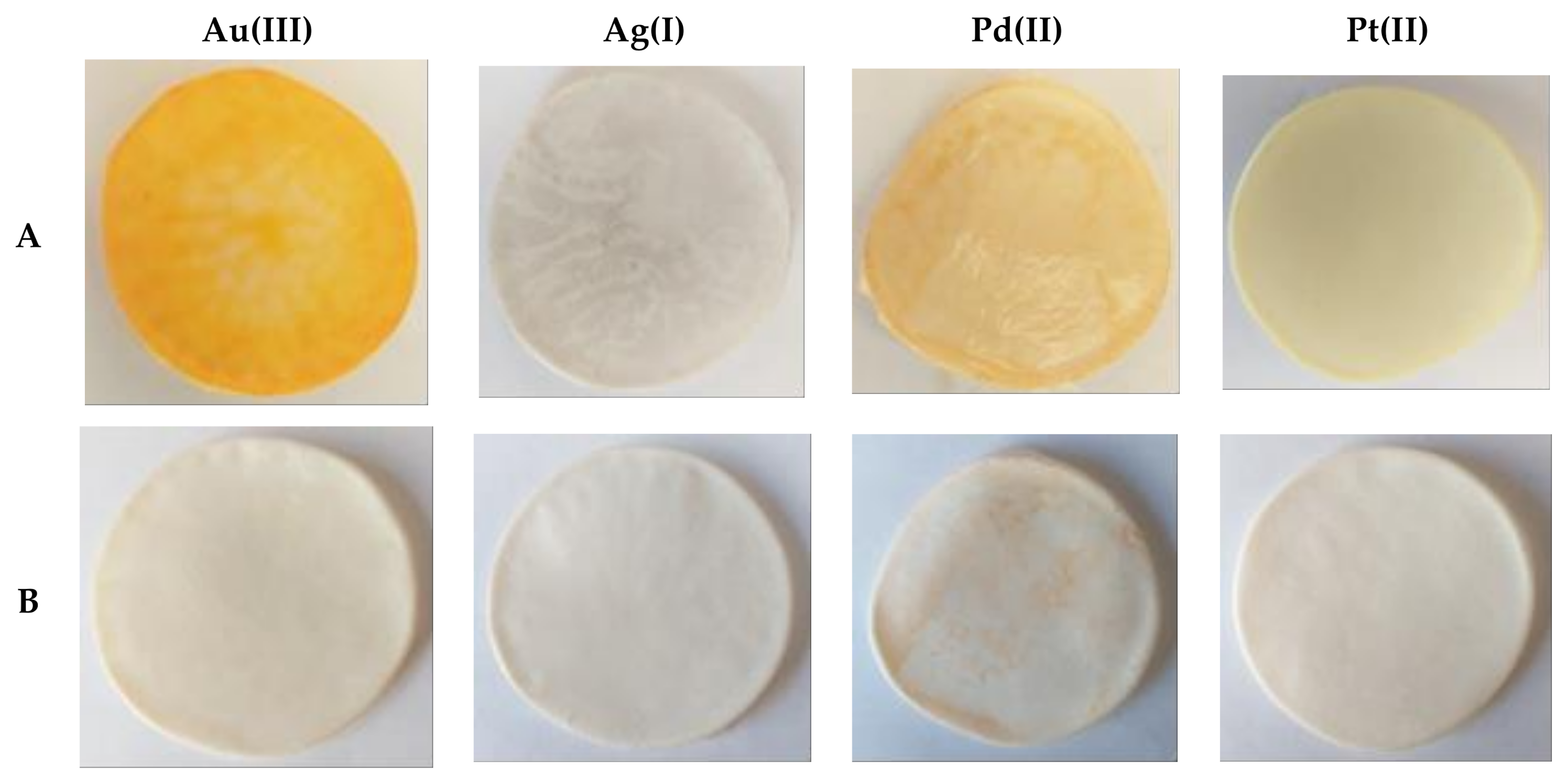
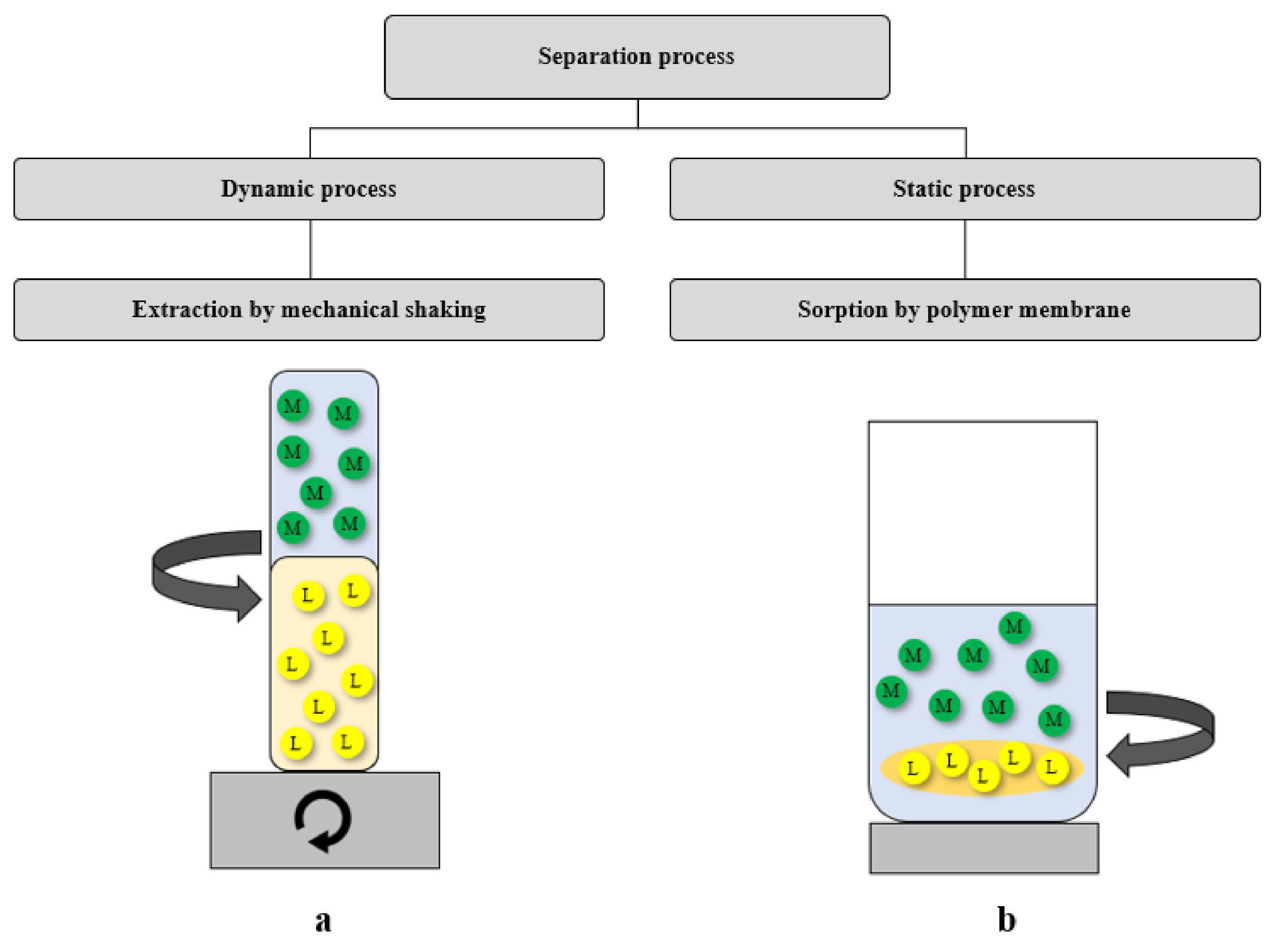
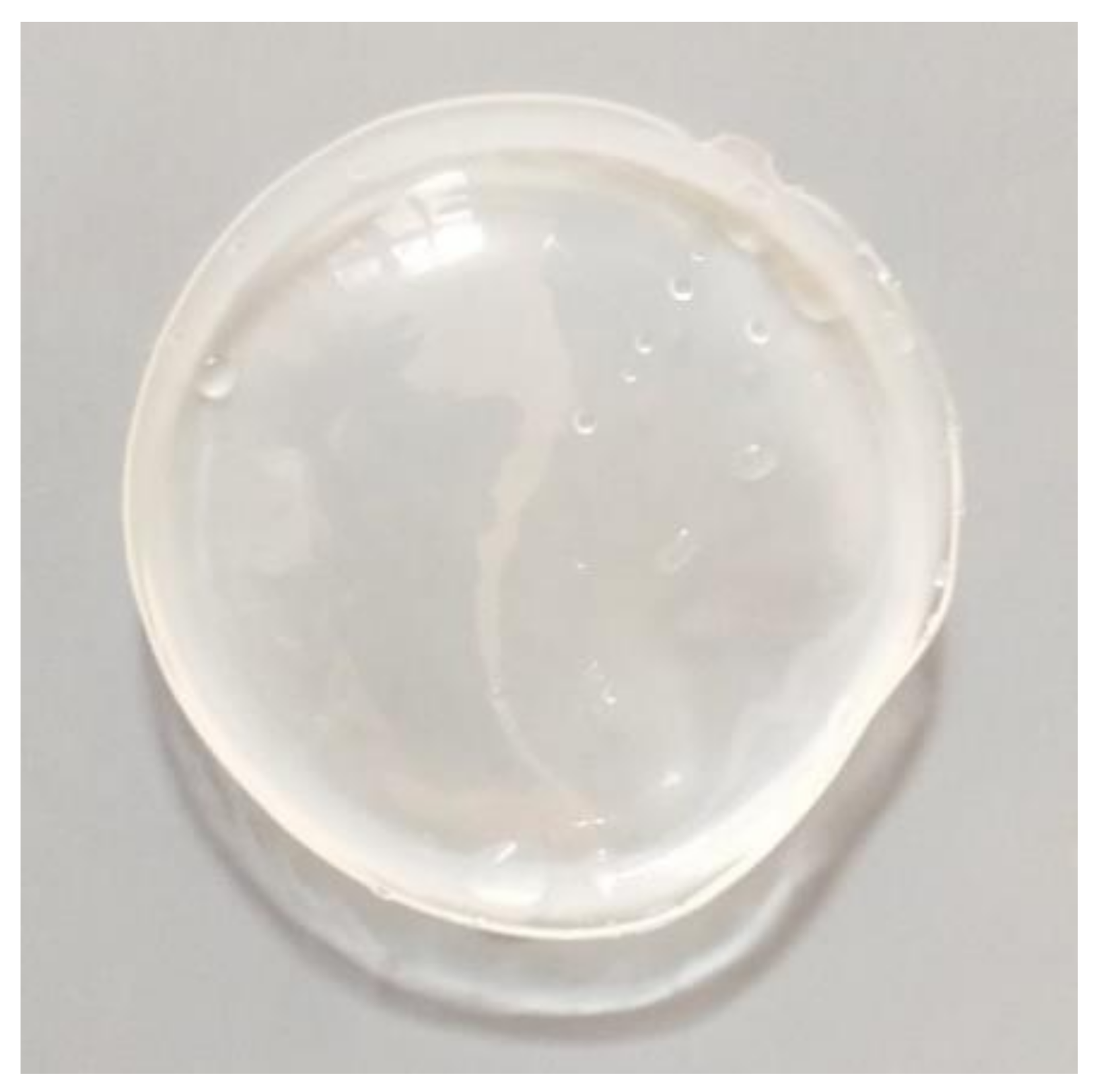
| Metal Ion | L—C21H19N3O4 | ||
|---|---|---|---|
| (L:M = 1:1) | (L:M = 1:2) | (L:M = 1:3) | |
| log K1 | log K2 | log K3 | |
| Au(III) | 5.540 | 4.851 | 4.607 |
| Ag(I) | 4.883 | - | - |
| Pd(II) | 4.917 | 5.398 | - |
| Pt(II) | 5.771 | 5.584 | - |
| Metal Ions Time [h] | Au(III) qt [mg/g] | Ag(I) qt [mg/g] | Pd(II) qt [mg/g] | Pt(II) qt [mg/g] |
|---|---|---|---|---|
| 4 | 0.3705 | 0.0326 | 0.0240 | 0.3794 |
| 6 | 0.3986 | 0.0388 | 0.3830 | 0.9588 |
| 12 | 0.5002 | 0.0923 | 0.4193 | 1.6790 |
| 24 | 0.9399 | 0.1080 | 0.6415 | 1.7516 |
| 2,6-Bis(4-methoxybenzoyl)-diaminopyridine | D2EHAG | ||||||||||
| Au(III) | Ag(I) | Pd(II) | Pt(II) | Ref. | Au(III) | Ag(I) | Pd(II) | Pt(II) | Ref. | ||
| SE | X | X | X | X | [This work] | SE | - | - | X | X | [29] |
| PM | X | X | X | X | [This work] | PM | X | - | - | - | [25] |
| Kelex 100 | Calix [4]pyrrole | ||||||||||
| Au(III) | Ag(I) | Pd(II) | Pt(II) | Ref. | Au(III) | Ag(I) | Pd(II) | Pt(II) | Ref. | ||
| SE | - | - | X | X | [30,31] | SE | - | - | - | - | - |
| PM | X | - | - | - | [32] | PM | - | X | X | - | [23,33,34] |
| Cyphos IL 101 | Cyphos IL 102 | ||||||||||
| Au(III) | Ag(I) | Pd(II) | Pt(II) | Ref. | Au(III) | Ag(I) | Pd(II) | Pt(II) | Ref. | ||
| SE | X | - | X | - | [35,36,37] | SE | X | - | X | - | [35,36,37] |
| PM | - | - | X | - | [37] | PM | - | - | X | - | [37] |
| Cyphos IL 104 | Cyanex 302 | ||||||||||
| Au(III) | Ag(I) | Pd(II) | Pt(II) | Ref. | Au(III) | Ag(I) | Pd(II) | Pt(II) | Ref. | ||
| SE | - | - | X | - | [38] | SE | X | X | X | - | [39,40,41,42] |
| PM | X | - | X | - | [37,42] | PM | - | - | - | - | - |
Publisher’s Note: MDPI stays neutral with regard to jurisdictional claims in published maps and institutional affiliations. |
© 2021 by the authors. Licensee MDPI, Basel, Switzerland. This article is an open access article distributed under the terms and conditions of the Creative Commons Attribution (CC BY) license (https://creativecommons.org/licenses/by/4.0/).
Share and Cite
Bożejewicz, D.; Witt, K.; Kaczorowska, M.A.; Urbaniak, W.; Ośmiałowski, B. The Application of 2,6-Bis(4-Methoxybenzoyl)-Diaminopyridine in Solvent Extraction and Polymer Membrane Separation for the Recovery of Au(III), Ag(I), Pd(II) and Pt(II) Ions from Aqueous Solutions. Int. J. Mol. Sci. 2021, 22, 9123. https://doi.org/10.3390/ijms22179123
Bożejewicz D, Witt K, Kaczorowska MA, Urbaniak W, Ośmiałowski B. The Application of 2,6-Bis(4-Methoxybenzoyl)-Diaminopyridine in Solvent Extraction and Polymer Membrane Separation for the Recovery of Au(III), Ag(I), Pd(II) and Pt(II) Ions from Aqueous Solutions. International Journal of Molecular Sciences. 2021; 22(17):9123. https://doi.org/10.3390/ijms22179123
Chicago/Turabian StyleBożejewicz, Daria, Katarzyna Witt, Małgorzata A. Kaczorowska, Włodzimierz Urbaniak, and Borys Ośmiałowski. 2021. "The Application of 2,6-Bis(4-Methoxybenzoyl)-Diaminopyridine in Solvent Extraction and Polymer Membrane Separation for the Recovery of Au(III), Ag(I), Pd(II) and Pt(II) Ions from Aqueous Solutions" International Journal of Molecular Sciences 22, no. 17: 9123. https://doi.org/10.3390/ijms22179123
APA StyleBożejewicz, D., Witt, K., Kaczorowska, M. A., Urbaniak, W., & Ośmiałowski, B. (2021). The Application of 2,6-Bis(4-Methoxybenzoyl)-Diaminopyridine in Solvent Extraction and Polymer Membrane Separation for the Recovery of Au(III), Ag(I), Pd(II) and Pt(II) Ions from Aqueous Solutions. International Journal of Molecular Sciences, 22(17), 9123. https://doi.org/10.3390/ijms22179123






